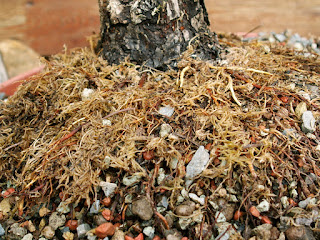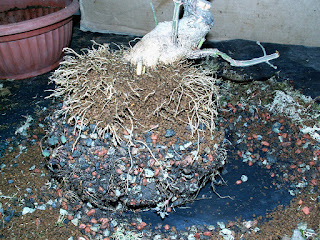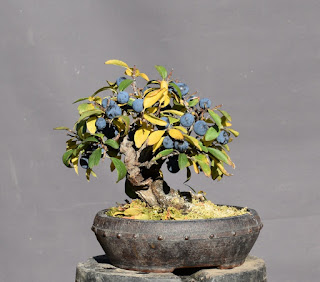Air layering
Water. Nutrients, Oxygen. Warm.
That is the basics to make and keep roots of our plant happy.
Substrate? This is "just" a king of anchoring medium and we can use different materials, providing we deliver the items in the first line.
I believe that the same should be applied trying to make a good airlayer.
A good airlayer. What do I mean by that? A process in which we will force the plant to produce a new set of roots at desired position.
That is: Numerous roots that grow all around the circumference of the trunk.
A great start to produce a flare in the lower part of the trunk with nicely spread radial surface roots. That was I believe the main/initial purpose of the air layering technique.
When it comes to airlayering a good start is importat. Bearing this in mind I start the preparation usually in the course of previous year. Main target - to get as much new growth as possible.
If the target is met, then I start the air layer. If not I skip it for next year.
Method: Strip of bark removed ( just bark with an inner part of cambium - I do not remove any wood as I think that this will destroy some of the vascular tissue in the xylem important for the transport of water and nutrients for the new roots ) . I am not using the technique with wire.
Cleaning the cut with a sharp knife and applying the rooting hormone. AS-1 in my case ( Niacin and NAA - naphthaleneacetic acid ). Just light dusting of the cut area. ( There is a paper claiming that too much of these hormones actually reduce the growth of new roots ).
Container: I use pond baskets as often as I can. Reason? Air circulation = oxygen for roots. Regarding its size - I try to have there enough space for horizontal development of roots. 7 -10 cm on each side. I believe that if there is less space the substrate may get dry faster =problems for new roots.
Substrate: An airy one. Mostly acadama,/kiriu and zeolithe mixture ( 3-5 mm I guess 50:50, but sometimes only acadama ) with a fresh sphagnum moss cut into very fine pieces. The finer the better to mix it well with the rest of the substrate. Never measured the amount of moss. Maybe 5% of total? The levels of substrate: 7-10 cm below the cut and 2-3 cm above it. And the top is covered with shredded sphagnum moss. As you can see - all the items are here to provide a good supply of water and oxygen. If you think of anything better then use it. You cannot fail.
Warmth: For the roots of native plants the zone of comfort is in the range of 25-30°C. So I try to keep the temperature of substrate around this range. That is not starting the airlayer too early in the spring and sheltering the container in the summer if the temperature of the soil may get higher. At the same time I think that starting much earlier in the spring should not be a problem.
Water: I am watering the plant in a normal regime. The container with airlayer is kept wet = watering 1 - 3 times per day.
Fertilising: Just the mother plant. I do not use fertiliser for the airlayer. On the other side - I do not think this will cause any problem if I do. The new roots are developing on the mother plant anyway even with heavy fertilising isn't it.
Control: I did my job at the beginning and now it is time the plant done its part. (Learning from Othmar Auer ) Providing I will deliver a good horticulture = plant grows without any restriction.
I leave my curious fingers out of job for at least 2-3 months. In August/ early September I would check the status and if it looks OK then the new plant is separated. If not then I leave it for next year. In such case I try to keep the plant in non frost area.
Potting:
A standard one. Trying not to disturb new roots as much as I can . Just placing in the new container ( I do prefer a wooden one - more stable environment with less fluctuation ) and filling with standard substrate 3-5 mm
Horticulture:
After the separation I reduce the number of branches on the new plant. We know there should be some kind of balance between the foliage and roots. Again, I am not too fussy about that. So I will cut off all sacrifice branches and leave only those that could be used for building the basic structure next year.
In winter - I guess non frost area is great. If not available then a good mulch should do the job as well.
European wild pear (Pyrus pyraster ) Autumn 2017
Rather a ground layer with a plastic colander. Zeolithe, terramol and sphagnum moss ( no cutting at that time )
European spindle (Euonymus europaeus ) Shohin starter ( Autumn 2018 )
Acadama.
European wild pear (Pyrus pyraster ) Autumn 2016
Please note the development of new roots and the position of the pond basket on the mother plant. Much better development on the leftish side. Was it because there was not enough space on the right side due to the position of the container? I think that limited space was another factor that caused faster drying and maybe a higher temperature of this zone. I may be quite well wrong but I try to avoid this situation if I can. Less space = less roots
Well, I guess this is about it. If I have missed anything just give me a shout.
Thank you for reading. Frankly we know it is not me behind all this but rather my plants who try to make me happy...
That is the basics to make and keep roots of our plant happy.
Substrate? This is "just" a king of anchoring medium and we can use different materials, providing we deliver the items in the first line.
I believe that the same should be applied trying to make a good airlayer.
A good airlayer. What do I mean by that? A process in which we will force the plant to produce a new set of roots at desired position.
That is: Numerous roots that grow all around the circumference of the trunk.
A great start to produce a flare in the lower part of the trunk with nicely spread radial surface roots. That was I believe the main/initial purpose of the air layering technique.
When it comes to airlayering a good start is importat. Bearing this in mind I start the preparation usually in the course of previous year. Main target - to get as much new growth as possible.
If the target is met, then I start the air layer. If not I skip it for next year.
An Airlayer
Timing: in May - early June in my place. No problem to start later though.Method: Strip of bark removed ( just bark with an inner part of cambium - I do not remove any wood as I think that this will destroy some of the vascular tissue in the xylem important for the transport of water and nutrients for the new roots ) . I am not using the technique with wire.
Cleaning the cut with a sharp knife and applying the rooting hormone. AS-1 in my case ( Niacin and NAA - naphthaleneacetic acid ). Just light dusting of the cut area. ( There is a paper claiming that too much of these hormones actually reduce the growth of new roots ).
Container: I use pond baskets as often as I can. Reason? Air circulation = oxygen for roots. Regarding its size - I try to have there enough space for horizontal development of roots. 7 -10 cm on each side. I believe that if there is less space the substrate may get dry faster =problems for new roots.
Substrate: An airy one. Mostly acadama,/kiriu and zeolithe mixture ( 3-5 mm I guess 50:50, but sometimes only acadama ) with a fresh sphagnum moss cut into very fine pieces. The finer the better to mix it well with the rest of the substrate. Never measured the amount of moss. Maybe 5% of total? The levels of substrate: 7-10 cm below the cut and 2-3 cm above it. And the top is covered with shredded sphagnum moss. As you can see - all the items are here to provide a good supply of water and oxygen. If you think of anything better then use it. You cannot fail.
Warmth: For the roots of native plants the zone of comfort is in the range of 25-30°C. So I try to keep the temperature of substrate around this range. That is not starting the airlayer too early in the spring and sheltering the container in the summer if the temperature of the soil may get higher. At the same time I think that starting much earlier in the spring should not be a problem.
Water: I am watering the plant in a normal regime. The container with airlayer is kept wet = watering 1 - 3 times per day.
Fertilising: Just the mother plant. I do not use fertiliser for the airlayer. On the other side - I do not think this will cause any problem if I do. The new roots are developing on the mother plant anyway even with heavy fertilising isn't it.
Control: I did my job at the beginning and now it is time the plant done its part. (Learning from Othmar Auer ) Providing I will deliver a good horticulture = plant grows without any restriction.
I leave my curious fingers out of job for at least 2-3 months. In August/ early September I would check the status and if it looks OK then the new plant is separated. If not then I leave it for next year. In such case I try to keep the plant in non frost area.
Potting:
A standard one. Trying not to disturb new roots as much as I can . Just placing in the new container ( I do prefer a wooden one - more stable environment with less fluctuation ) and filling with standard substrate 3-5 mm
Horticulture:
After the separation I reduce the number of branches on the new plant. We know there should be some kind of balance between the foliage and roots. Again, I am not too fussy about that. So I will cut off all sacrifice branches and leave only those that could be used for building the basic structure next year.
In winter - I guess non frost area is great. If not available then a good mulch should do the job as well.
European wild pear (Pyrus pyraster ) Autumn 2017
Rather a ground layer with a plastic colander. Zeolithe, terramol and sphagnum moss ( no cutting at that time )
 |
| Add caption |
European spindle (Euonymus europaeus ) Shohin starter ( Autumn 2018 )
Acadama.
European wild pear (Pyrus pyraster ) Autumn 2016
Please note the development of new roots and the position of the pond basket on the mother plant. Much better development on the leftish side. Was it because there was not enough space on the right side due to the position of the container? I think that limited space was another factor that caused faster drying and maybe a higher temperature of this zone. I may be quite well wrong but I try to avoid this situation if I can. Less space = less roots
Well, I guess this is about it. If I have missed anything just give me a shout.
Thank you for reading. Frankly we know it is not me behind all this but rather my plants who try to make me happy...






Great post. Thanks
ReplyDelete